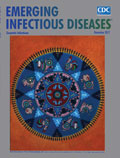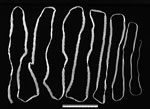
Volume 23, Number 12—December 2017
Etymologia
Etymologia: Taenia saginata

Figure. Ad Taenia saginata tapeworm. Photo CDC/1986.
Johann Goeze is credited with the first correct description of Taenia [Latin, “flat band” or “ribbon”] saginata[Latin, “fed”], commonly known as the beef tapeworm, in 1782. Historically, Taenia tapeworms (Figure) were believed to have infected humans no more than 10,000 years ago, around the time of domestication of cows and pigs.
However, more recent phylogenetic evidence suggests that ancestors of modern humans, living on the savannahs of Africa and preying on antelope and other bovids, became colonized with Taenia >3 million years ago. Parasite definitive hosts switched from large carnivores (probably hyenas) to hominids through their common prey, and this process triggered the evolution of human-infecting species of Taenia. Humans later spread these parasites to domestic animals.
References
- Despommier DD, Gwadz RW, Hotez PJ. Taenia saginata (Goeze 1782). In: Parasitic Diseases. 3rd ed. New York: Springer; 1995. p.76–80.
- Hoberg EP, Alkire NL, de Queiroz A, Jones A. Out of Africa: origins of the Taenia tapeworms in humans. Proc Biol Sci. 2001;268:781–7. DOIPubMed
- Terefe Y, Hailemariam Z, Menkir S, Nakao M, Lavikainen A, Haukisalmi V, et al. Phylogenetic characterisation of Taenia tapeworms in spotted hyenas and reconsideration of the “Out of Africa” hypothesis of Taenia in humans. Int J Parasitol. 2014;44:533–41. DOIPubMed
- Zarlenga DS, Hoberg E, Rosenthal B, Mattiucci S, Nascetti G. Anthropogenics: human influence on global and genetic homogenization of parasite populations. J Parasitol. 2014;100:756–72. DOIPubMed





















.jpg)












No hay comentarios:
Publicar un comentario